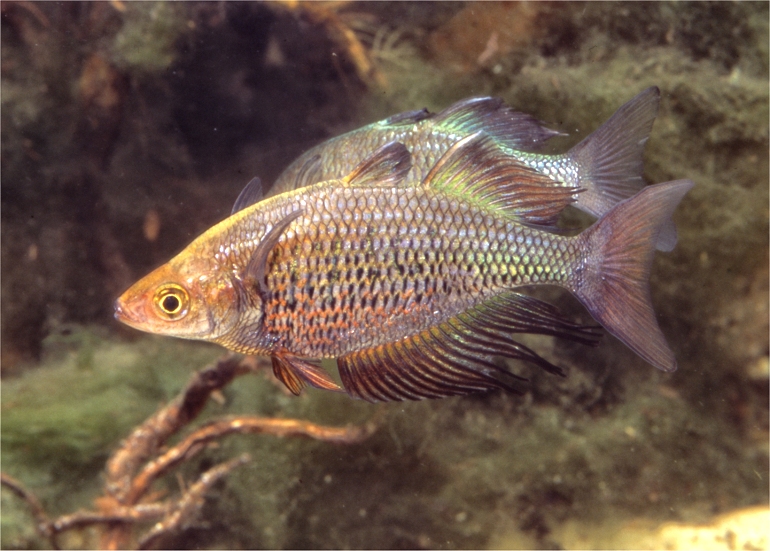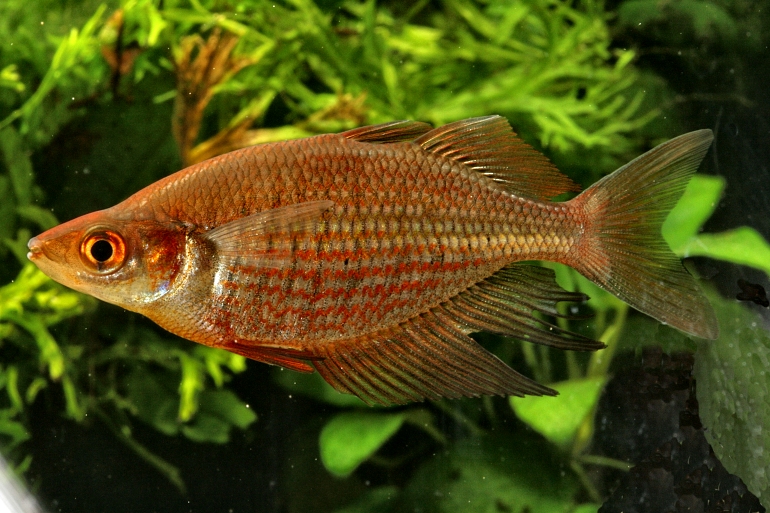|
 |
Glossolepis multisquamata [Lake Kli] - photo© Gunther Schmida |
(Weber and de Beaufort, 1922)
Mamberamo Rainbowfish
Species Summary
Glossolepis multisquamata have an overall body colouration of olive-green to silvery with a rosy glow across the sides. There is a series of narrow orange-red lines between each scale row and the fins are usually clear, greenish-yellow, or sometimes nearly black. The orange-red lines on the sides are much brighter in mature males giving the body an overall reddish colour. Males also have a bright red eye. They may reach a maximum size of 14 cm, but are usually around 10-12 cm. Most fish collected have been within the range 6-10 cm. Adults become very deep bodied especially the males (6-8 cm), although this difference is not obvious in young adults less than about 6 cm SL.
Distribution & Habitat
Glossolepis multisquamata is currently found in lakes, slow-flowing streams and backwaters of the Mamberamo river system in West Papua. They were originally collected from the Idenburg River (= Taritatu River) in the Mamberamo region by the Dutch zoologist and explorer W. C. van Heurn in 1920. They were also collected from the Doorman River, a major tributary of the Taritatu.
The Mamberamo region is not well-studied but possesses a wealth of biodiversity. The first scientific fish collections from the Mamberamo were made by van Heurn in 1920-21. These collections were mainly described by Weber and de Beaufort (1911-1962). There have been some other expeditions; 1938-1939 (Archbold expedition) and Gerald Allen did some surveys in this area. Several locations within the Mamberamo catchment, including Danau Biru, Obogwi, Faui, Kordesi, Dabra, Nevere, and Senggi were surveyed by Gerald Allen between 1982 and 1991.
The Mamberamo River (also called Tarikaikea) is the largest in northern West Papua, draining a catchment that encompasses all northward flowing streams descending from the New Guinea central mountains between the Papua New Guinea border and approximately 137° west longitude. The source of the river is formed from the confluences of its upper tributaries, the Tariku, Van Daalen and Taritatu Rivers. The Tariku River (previously known as the Rouffaer River) in the west flows eastward and the Taritatu River (previously known as the Idenburg River) in the east flows roughly westward. They meet in the Meervlakte Basin to form the main Mamberamo River. Extensive inland swamps surround the Taritatu and Tariku rivers in the central depression of the Lakes-Plains province. Beyond the confluence of Tariku and Taritatu, the Mamberamo flows abruptly northwards 175 km through the Van Rees Range to reach the lowland marshes of its broad river delta on the coast at Cape D'Urville on the northeast margin of Cenderawasih Bay. The Mamberamo River has a total length about 1000 km; the Taritatu is about 467 km long; the Tariku 327 km; and the Mamberamo itself is about 283 km long.
 |
Glossolepis multisquamata [Pagai, Mamberamo] - photo© Johannes Graf |
Remarks
Gerald Allen collected a number of live rainbowfishes in 1979, while collecting in the Sepik-Ramu River region, and brought them back to Australia where they were subsequently bred and distributed in the hobby. He later identified them as Glossolepis multisquamatus. Heiko Bleher also collected live specimens from the same area and another collection near the Ramu River and took them back to Europe. However, it is thought that none of these fish still remain in captivity.
Heiko Bleher also collected a number of Glossolepis specimens from the Mamberamo region in 1992. It was unclear whether these specimens represented an undescribed species or perhaps just a colour variation of G. multisquamata. Heiko Bleher had collected this form a couple of times and reported that in his opinion they were quite different from the Sepik/Ramu form (H. Bleher per. comm.). These species were bred and distributed in Australia under the common name of "Red-eyed Tiger Rainbowfish". In Europe, they were generally known as Glossolepis sp. (Mamberamo). Around 1993, Heiko Bleher collected another rainbowfish from Lake Kli in the Mamberamo valley. It is generally known in the hobby as Glossolepis sp. (Lake Kli) or as the Fringefin Rainbowfish. Since then there has been a number of collections by individual aquarists and some of these forms are currently available in the hobby.
As it turns out, the specimens from the Mamberamo region are the true Glossolepis multisquamata while those from the Sepik-Ramu River system are considered to be Glossolepis kabia. The Mamberamo River specimens are quite different, but the most obvious difference is they have a large anal fin, which are reminiscent of Glossolepis wanamensis.
Literature
Allen G.R. (1980) A Generic Classification of the Rainbowfishes (Family Melanotaeniidae). Records of the Western Australian Museum 8 (3): 449-490.
Allen G.R. (1991) Field guide to the freshwater fishes of New Guinea. Christensen Research Institute, Madang, Papua New Guinea.
Allen G.R. & S.J. Renyaan (1998) Three new species of rainbowfishes (Melanotaeniidae) from Irian Jaya, Indonesia. aqua 3(2):69-80.
Graf J. & H.L. Ohee (2009) Glossolepis from Northern New Guinea. Fishes of Sahul 23(2): 502-512.
Weber M. & L.F. de Beaufort (1922) The Fishes of the Indo-Australian Archipelago. IV. Heteromi, Solenichthyes, Synentognathi, Percesoces, Labyrinthici, Microcyprini. E. J. Brill, Leiden, 4: 1-410.
Adrian R. Tappin
Updated August, 2015



|

